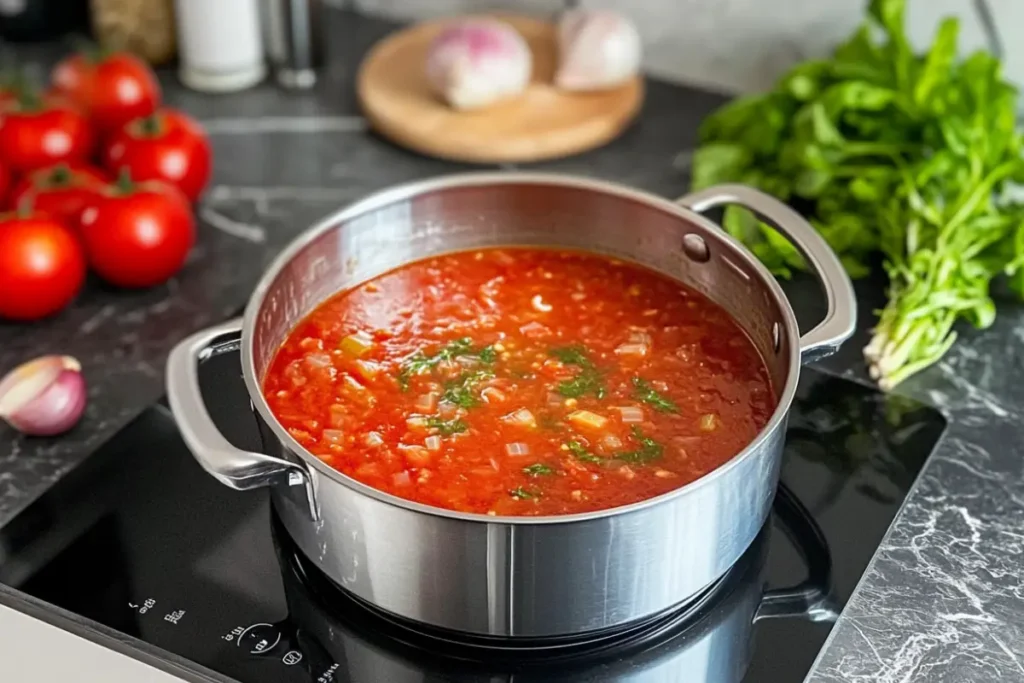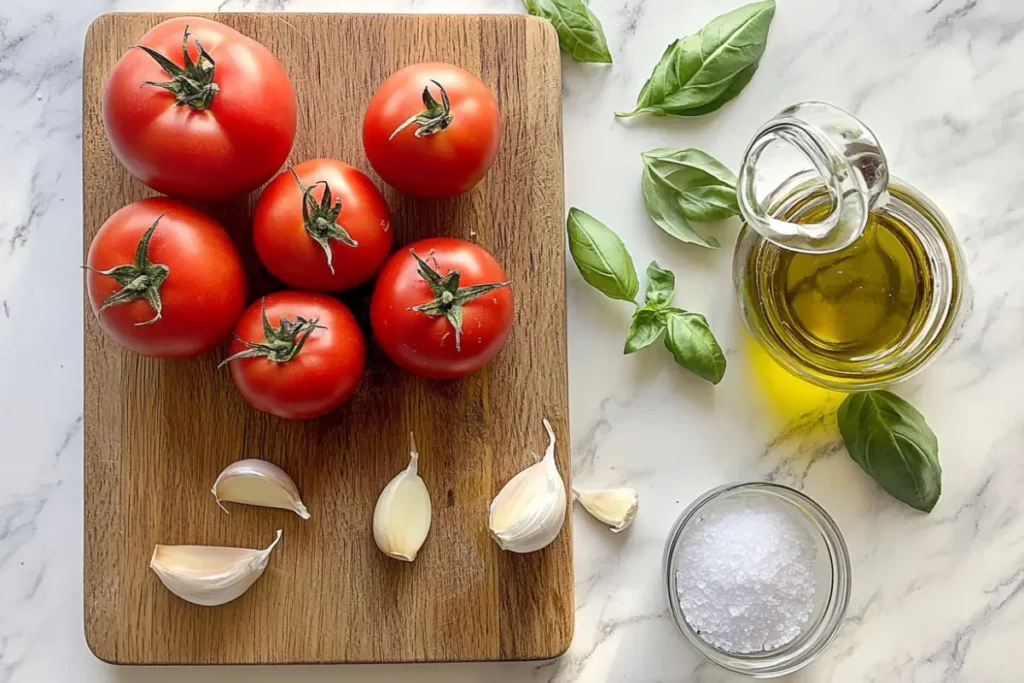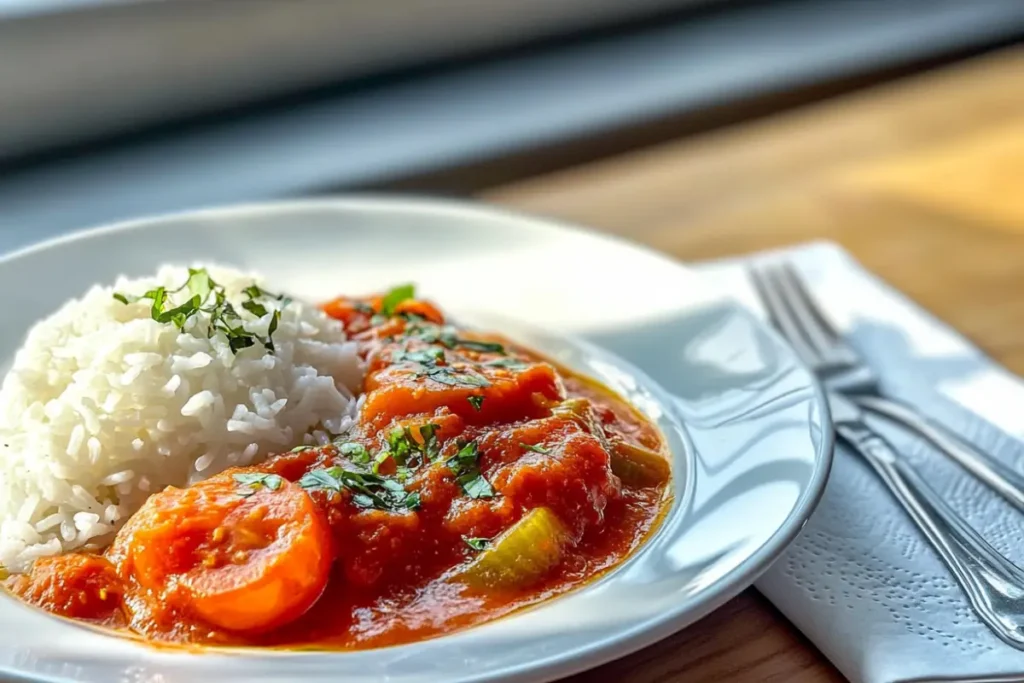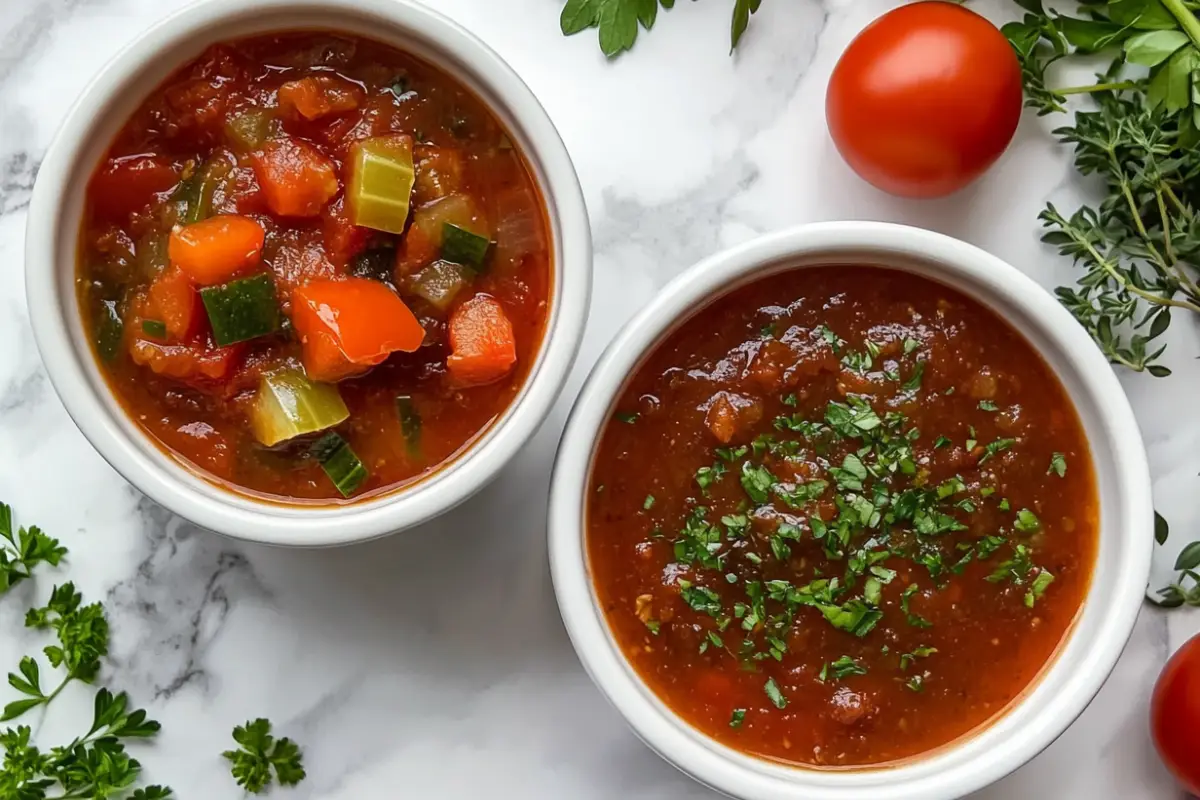Last Updated on March 7, 2025 by Simon
If you’ve ever stood in the kitchen wondering whether to use tomato stew or tomato sauce in your dish, you’re not alone. While both are tomato-based and can serve as a base for various recipes, they differ significantly in ingredients, preparation, texture, and usage. In this article, we’ll break down the key differences between tomato stew and tomato sauce and address the most common questions people have about these two beloved staples in many cuisines.
Table of contents
- What Is Tomato Stew?
- What Is Tomato Sauce?
- Key Differences Between Tomato Stew and Tomato Sauce
- Which One Should You Use in Your Recipes?
- Is Tomato Stew the Same as Marinara Sauce?
- Can You Substitute Tomato Sauce for Tomato Stew?
- Is Tomato Stew Healthier Than Tomato Sauce?
- Can You Make Tomato Sauce from Tomato Stew?
- Common Mistakes to Avoid When Making Tomato Stew or Tomato Sauce
- Nutritional Comparison: Tomato Stew vs. Tomato Sauce
- Substitutes for Each One
- Pairing Ideas: Dishes to Serve with Each One
- FAQs
- Final Thoughts
What Is Tomato Stew?
Tomato stew is a hearty, chunky dish made with tomatoes as the base, often combined with other vegetables, herbs, and spices. It can be cooked with or without meat, and its consistency is thick and rustic.
Tomato stews are common in many cultures. In West African cuisine, for instance, tomato stew is a staple served with rice or yam. In Mediterranean dishes, tomato stew may include olives, capers, and even seafood. The essential feature of a tomato stew is that it’s a one-pot dish, slow-cooked to build layers of flavor.

Characteristics of Tomato Stew:
- Chunky and hearty consistency
- Often includes meat, fish, or vegetables
- Slow-cooked for rich, deep flavors
- Served as a main dish or side dish
What Is Tomato Sauce?
Tomato sauce, on the other hand, is a smoother, more liquid preparation typically used as a base for other dishes. It’s commonly found in Italian cuisine, where it forms the foundation of pasta dishes, pizzas, and more. While the base is always tomatoes, tomato sauces often include garlic, onions, olive oil, and herbs like basil and oregano.
Tomato sauce is usually simmered for a shorter time compared to tomato stew, resulting in a smoother texture and a lighter flavor. Some varieties of tomato sauce are further blended to achieve a completely smooth consistency.

Characteristics of Tomato Sauce:
- Smooth or semi-smooth texture
- Can be plain or flavored with herbs, garlic, and onions
- Used as a base or condiment in various recipes
- Typically cooked for a shorter time compared to stews
Key Differences Between Tomato Stew and Tomato Sauce
Let’s compare tomato stew vs. tomato sauce side by side to see their differences more clearly:
| Feature | Tomato Stew | Tomato Sauce |
|---|---|---|
| Texture | Chunky and hearty | Smooth or semi-smooth |
| Cooking Time | Slow-cooked for rich flavors | Simmered for a shorter time |
| Ingredients | Includes meat, fish, or vegetables | Focuses on tomatoes and seasonings |
| Usage | Served as a main or side dish | Used as a base or condiment |
| Common Cuisines | West African, Mediterranean | Italian, American |
Which One Should You Use in Your Recipes?
The choice between stew and sauce depends on the type of dish you’re making:
- Use tomato stew when you want a hearty, filling dish that can stand on its own. It’s perfect for meals like rice and stew, yam porridge, or stewed vegetables.
- Use tomato sauce when you need a base for other recipes. It’s ideal for dishes like spaghetti Bolognese, pizza, or lasagna.
Is Tomato Stew the Same as Marinara Sauce?
No, tomato stew is not the same as marinara sauce. Marinara sauce is a type of tomato sauce, typically made with tomatoes, garlic, onions, and herbs. It has a smoother texture and is often used as a base for pasta dishes. Tomato stew, on the other hand, is chunkier and can include a variety of vegetables, meats, or fish.
The difference lies in their preparation and usage:
- Marinara sauce is a smooth sauce used for pasta, pizzas, and dipping.
- Tomato stew is a hearty, standalone dish, often served with starches like rice or potatoes.
Can You Substitute Tomato Sauce for Tomato Stew?
It’s possible to substitute tomato sauce for tomato stew, but it will change the overall flavor and texture of your dish. If you need a quick fix and only have tomato sauce, you can add chunks of vegetables or meat to mimic the texture of stew. However, the sauce won’t have the same depth of flavor as a slow-cooked stew.
If you’re making a dish like jollof rice or stewed beans, tomato stew is a better choice because it adds more richness and substance. For pasta or pizza, tomato sauce is a better fit.
Is Tomato Stew Healthier Than Tomato Sauce?
Both tomato stew and tomato sauce can be healthy options, but it depends on the ingredients used. Let’s look at the factors that affect the nutritional value of each:
- Tomato Stew: Often includes vegetables and proteins, which add nutrients. However, depending on the recipe, it may also have added fats from oils or meats.
- Tomato Sauce: Usually lower in calories if it’s made with basic ingredients. Store-bought versions may have added sugars and preservatives, which can reduce their health benefits.
To keep both options healthy, try making them at home with fresh ingredients and minimal added fats or sugars.
Can You Make Tomato Sauce from Tomato Stew?
Yes, you can turn tomato stew into tomato sauce by blending it and adjusting the seasoning. Here’s how you can do it:
How to Turn Tomato Stew into Tomato Sauce:
- Remove any large chunks of meat or vegetables.
- Blend the remaining stew until smooth using an immersion blender or a regular blender.
- Simmer the blended mixture to thicken it, if necessary.
- Adjust the seasoning by adding herbs like basil or oregano.
This method is a great way to repurpose leftovers and reduce food waste.
Common Mistakes to Avoid When Making Tomato Stew or Tomato Sauce
- Using the Wrong Tomatoes
Not all tomatoes work well for stew or sauce. Slicing tomatoes or cherry tomatoes can be too watery, resulting in a thin and bland dish.
Solution: Use Roma, San Marzano, or plum tomatoes, which have fewer seeds and a richer, more concentrated flavor. - Overcooking Tomato Sauce
While slow cooking helps develop flavor, simmering sauce for too long can make it bitter or overly acidic.
Solution: Most tomato sauces need only 30 to 45 minutes of cooking. Taste the sauce periodically to avoid overcooking. - Skipping the Sauté Step
Adding raw onions and garlic directly to the stew or sauce without sautéing them first can lead to a flat-tasting dish.
Solution: Sauté onions and garlic in oil until golden brown before adding tomatoes. This step adds depth of flavor and richness. - Adding Too Much Water
Adding excess water to tomato stew or sauce can dilute the flavor and make it too thin.
Solution: Start with a small amount of liquid, then adjust as needed while cooking. You can always add more if necessary, but it’s hard to remove excess liquid once added.
Nutritional Comparison: Tomato Stew vs. Tomato Sauce
When deciding between tomato stew and tomato sauce, many home cooks also wonder about their nutritional differences. While both dishes can be healthy additions to your meals, their calorie content, nutrient density, and overall health benefits can vary depending on the ingredients used.
Calories and Fat Content
- Tomato Stew: Since tomato stew often includes meat, fish, or extra oil, it can be higher in calories and fat than tomato sauce. The type of meat or oil used will significantly impact its nutritional value. For a healthier option, try using lean proteins (like chicken or fish) and reducing oil.
- Tomato Sauce: A basic homemade tomato sauce is typically lower in calories and contains less fat. However, if you’re using a store-bought version, beware of added sugars, sodium, and preservatives that can reduce its health benefits.
Vitamins and Nutrients
Both tomato stew and tomato sauce are rich in antioxidants, particularly lycopene, which is found in cooked tomatoes and has been linked to lower risks of heart disease and cancer. They are also good sources of vitamin C, potassium, and fiber.
| Nutrient | Tomato Stew (per serving) | Tomato Sauce (per serving) |
|---|---|---|
| Calories | 150-250 (varies by recipe) | 80-120 (homemade) |
| Fat | 7-15g (with oil/meat) | 2-5g |
| Vitamin C | High | High |
| Fiber | Moderate | High |
| Lycopene | High | High |
For a healthier tomato stew or sauce:
- Use fresh tomatoes instead of canned products with added sugars.
- Limit added salt and fats.
- Include more vegetables in the stew to boost fiber and nutrients.
Substitutes for Each One
Sometimes, you might not have tomato stew or tomato sauce on hand, and you’ll need a quick substitute. Here’s how you can swap them out for other tomato-based products.
Tomato Stew Substitutes
- Tomato Paste: Mix 1 part tomato paste with 2 parts water to mimic the texture of stew. Add spices, onions, and any other ingredients you like to give it more depth.
- Crushed Tomatoes: Use canned or fresh crushed tomatoes as a base and cook them with vegetables and proteins to create a stew-like consistency.
- Salsa: For a twist, use salsa as a tomato stew replacement in dishes like tacos or enchiladas.
Tomato Sauce Substitutes
- Tomato Puree: This can be used directly as a sauce or adjusted with spices and herbs for more flavor.
- Ketchup: While not ideal for all dishes, ketchup can work in a pinch when making sauces for sandwiches or burgers.
- Sofrito: A Latin American base made from tomatoes, garlic, onions, and peppers, which can be a flavorful alternative.
Pairing Ideas: Dishes to Serve with Each One

Knowing which dishes pair best with each one can take your meals to the next level. Here are some pairing suggestions to inspire your next meal.
What to Serve with Tomato Stew
- Rice: Tomato stew is commonly served with white rice, brown rice, or jollof rice.
- Yam or Plantain: In West African cuisine, tomato stew is often paired with boiled yam or fried plantains.
- Bread: Serve it with crusty bread or flatbread to soak up the flavorful sauce.
- Pasta: For a twist, the stew version can also be served over pasta as a hearty alternative to traditional tomato sauce.
What to Serve with Tomato Sauce
- Pasta Dishes: The most popular pairing for tomato sauce is spaghetti, penne, or lasagna.
- Pizza: Use tomato sauce as a base for your favorite pizza toppings.
- Meatballs: Classic Italian meatballs are delicious when simmered in tomato sauce.
- Grilled Vegetables: Use tomato sauce as a dipping sauce for grilled or roasted vegetables.
- Seafood: Tomato sauce pairs beautifully with grilled fish or shrimp for a Mediterranean-inspired meal.
FAQs
Yes! Both tomato stew and tomato sauce can be frozen for up to 3 months. Make sure to store them in airtight containers or freezer bags to avoid freezer burn. Thaw them in the refrigerator overnight before reheating.
Yes, homemade versions of both tomato stew and sauce are healthier because you can control the ingredients and avoid added sugars, preservatives, and excess sodium. Use fresh tomatoes and herbs to maximize nutritional value.
For both dishes, it’s best to use Roma tomatoes, San Marzano tomatoes, or any plum variety. These types of tomatoes are preferred because they contain fewer seeds and have less water content compared to other varieties. As a result, they produce a thicker consistency and a more concentrated, richer flavor, which makes them ideal for cooking flavorful stews and sauces.
If your tomato sauce tastes too acidic, try adding a pinch of sugar or a splash of cream to balance the acidity. Cooking the sauce for longer also helps reduce acidity.
Yes, tomato sauce makes a great pizza base. Just make sure it’s not too watery. For best results, use a thick tomato sauce seasoned with herbs like basil, oregano, and garlic.
To thicken tomato stew, let it simmer uncovered until it reduces. For tomato sauce, you can add a small amount of tomato paste or simmer it longer to achieve the desired consistency.
Final Thoughts
Understanding the difference between tomato stew and tomato sauce is essential for choosing the right ingredient for your dishes. While both are made from tomatoes, their texture, cooking method, and intended use set them apart.
Tomato stew is hearty, chunky, and slow-cooked, making it a perfect main or side dish. Tomato sauce, on the other hand, is smoother and typically used as a base for other recipes like pasta and pizza.
By knowing their unique characteristics and when to use each, you can elevate your cooking and bring out the best flavors in your dishes.
If you’re feeling inspired to try a new tomato-based dish, why not explore a unique take on stew? Check out our Authentic Chilean Tomato Stew Recipe for a Flavorful Meal to discover how this vibrant and hearty dish is prepared in Chilean cuisine. It’s the perfect way to put your newfound knowledge into practice and add an international twist to your cooking!

